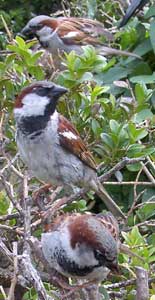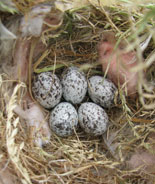 House Sparrows “average three broods per mating season with each brood containing four to seven eggs, with 20 offspring a year average. … If unchecked, a breeding pair can grow to over 2,000 birds in two to three years.” (From Bird Barrier America, Inc., .)
House Sparrows “average three broods per mating season with each brood containing four to seven eggs, with 20 offspring a year average. … If unchecked, a breeding pair can grow to over 2,000 birds in two to three years.” (From Bird Barrier America, Inc., .)
Densities may be as high as 3108-3367 birds/mi2 (1,200 – 1,300 individuals/km2) around dwellings associated with livestock; average of 518/mi2 (200/km2) in rural areas (Dyer et al. 1977).
House Sparrows probably live 1-3 years in the wild, to a maximum of 13years. (McLoughlin indicates that one captive sparrow lived23 years. According to a UMBC Bluebird Trail paper, existing records suggest that bluebirds can live up to 10 years in the wild, although the average life span is 3 to 7 years.)
I did some math (note that I have not validated these numbers scientifically.)
Assuming:
- average of 20 chicks per year per pair
- 50% of chicks survive (I’ve seen statistics of 40-60% mortalityfor HOSP)
- Half of chicks are female, half male(so 2 birds=1 pair), and they don’t mind inbreeding
- they don’tmate till year 2 (although they can reach sexual maturity at9 mos. per McLoughlin)
- they only mate for one year and then die
 Then THEORETICALLY:
Then THEORETICALLY:
2 birds (one pair) could quintuple the population in one year, and could theoretically multiply to 1,250 birds in 5 years.
Year 1: 2 birds (one pair: one male, one female)
Year 2: 10 birds (first pair died, but produced 10 offspring that lived =5 new pairs)
Year 3: 50 birds (5 pairs bred, produced 10 chicks per pair)
Year 4: 250 birds (25 pairs from previous year x 10 chicks per pair)
Year 5: 1,250 birds (125 pairs from previous year x 10 chicks per pair)
I don’t even want to THINK of the worst-case scenario.
MORE INFORMATION & RESOURCES:
Most people do not quit fighting Asian beetles, rats, cockroaches, fleas, mosquitoes, mold, dust, or grime by saying “Oh, there’s so many of them, that nothing can be done.” Persistence will win.
– Dottie Rooseboom
It is a battle, and a battle that can be won.
– Paula Ziebarth
